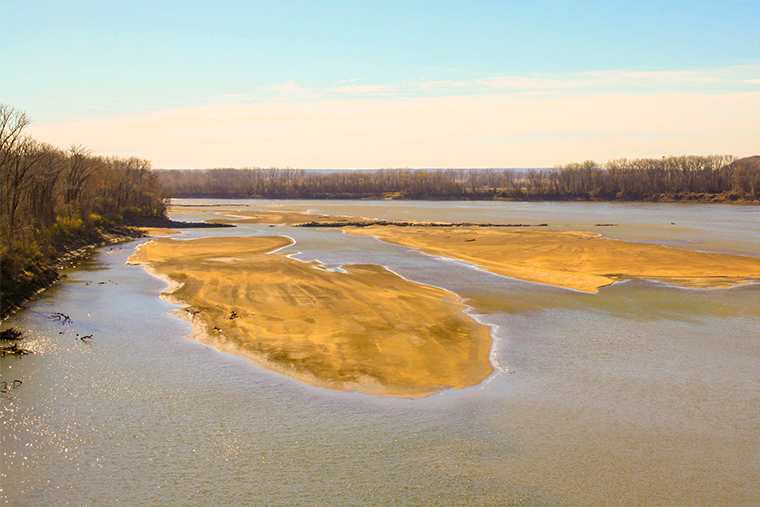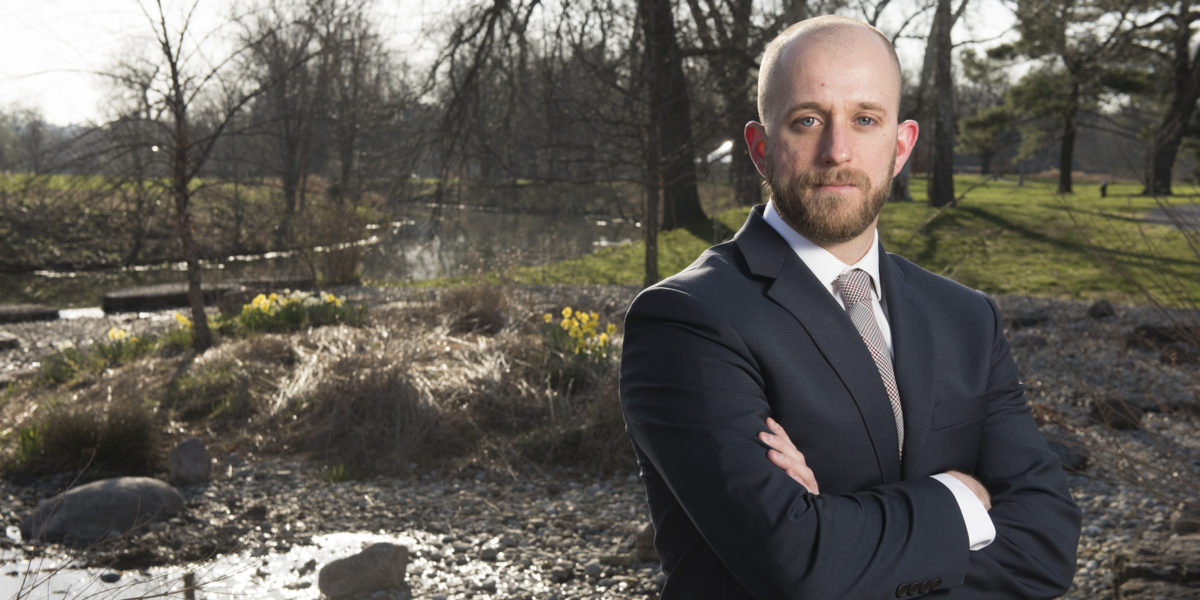The Missouri River is the longest and, by some accounts, most heavily engineered river in the United States. From its headwaters in the Rocky Mountains in western Montana, it stretches for more than 2,300 miles through a massive system of dams, reservoirs and levees before emptying into the Mississippi River just north of St. Louis.
For Tim Briscoe, a juris doctorate degree candidate in the School of Law at Washington University in St. Louis, the Missouri River is more than an overbuilt local waterway.
It is the scene of a battle with an unlikely set of protagonists: the Army Corps of Engineers, the U.S. Fish and Wildlife Service, and two birds and a fish.
Before he found himself evaluating the Corps’ ambitious management plan for the Missouri River, Briscoe did not know about the interior least tern, the Northern Great Plains piping plover, or the pallid sturgeon. He didn’t know about engineered sandbars, flow rates or what they mean for the animals’ survival. He had never even heard of these species, let alone encountered one in person — though he later was delighted to stumble upon a fine example of the prehistoric-looking sturgeon at the Saint Louis Zoo.
But he had always loved water. Briscoe, 25, played competitive men’s water polo as an undergraduate at the University of Illinois, where his thesis focused on jurisdictional challenges of the Clean Water Act. He swam breaststroke on his high school swim team, and he still swims recreationally at Millstone Pool a few times each week.
“There’s a connection between my interest in water law and growing up swimming in the water — literally,” Briscoe said.
He grew up in northwestern Illinois near the Fox River, which has its own complicated history of pollution and environmental cleanup.
His early introduction to environmental issues came with swimming and boating on the Fox. Briscoe frequently saw oil slicks, and dead fish floating nearby. They made an impression.
Rolling up his sleeves
At Washington University, Briscoe declared his interest in environmental law from the start. During his first summer, he interned at the Great Rivers Environmental Law Center in St. Louis, and he worked at the EPA Office of Regional Counsel in Chicago during his second. In fall 2017, he served as a law clerk at the Environmental Law Institute in Washington, D.C.
Then in spring 2017, he rolled up his sleeves for the Missouri River, under the auspices of Washington University’s Interdisciplinary Environmental Clinic (IEC).

The IEC represents nonprofit groups, communities and individuals who are pursuing legal action to protect the environment and community health but who cannot afford the legal representation and scientific expertise this requires.
Working as a student attorney for the IEC, Briscoe represented the Missouri Coalition for the Environment in preparing and delivering a formal comment on the Corps’ Draft Missouri River Recovery Management Plan and Environmental Impact Statement. When the comment was submitted, it was endorsed by seven nonprofit environmental organizations.
“The proposal itself was massive, containing thousands of pages of statistics, scientific studies, economic projections and other analysis designed to support the Corps’ vision,” said Elizabeth Hubertz, lecturer in law, who oversaw Briscoe’s work with the IEC and, subsequently, his pretrial procedure course at the law school.
“Tim’s role was to evaluate the proposal and determine whether it was protective of the environment and met the requirements of the Endangered Species Act,” she said.
“This was a daunting challenge, in terms of the size and complexity of the undertaking,” Hubertz said. “One of the first things Tim worked on was convincing the Corps to allow the clinic’s clients more time to prepare a response in light of the project’s sheer immensity. Tim then prepared and gave oral testimony at a hearing held by the Corps, challenging landowners and barge traffickers who hoped to persuade the Corps that ‘two birds and a fish’ were not worth saving.”
In the formal administrative comment that he prepared, Briscoe argued that the Corps is using an outdated biological assessment as a snapshot of the health of the species in question. He and Gabby Riek, a 2017 graduate who majored in chemical engineering in the School of Engineering & Applied Science and also worked with the IEC, determined that the science behind the Corps’ plan to build engineered sandbars as habitat was debatable — and that there was reason to suspect that they might never pile up the way the Corps said they would.
Finally and most importantly, Briscoe said, the Corps presented a loaded set of “alternatives” for mechanical sandbar habitat construction that they represented as the full the range of possible management actions — despite being heavily weighted toward one particular solution.
“We call this an unreasonable range of alternatives,” Briscoe said. “They should have presented a solution that offered a middle ground. Even if the flows had more scientific basis, why not create a more middle ground alternative? Like, let’s build 1,500 — or 1,000 — or 500 acres of sandbar habitat. Why not?
“The best legal arguments are often the most clear,” he said. “And that’s what we’ve tried to do here. We said, ‘You have inflated the cost of the most environmentally beneficial alternative, and it’s massively different than all of the others. And you simply do not explain why you cannot choose middle ground alternatives.’ ”
The perfect balance
As an environmentalist, Briscoe is less crunchy granola, and more clean-cut and practical. He has close-cropped blond hair and kind blue eyes, but his gaze is unflinching. His family has always valued life in public service, with all of its sacrifices: his dad was a police officer in the Chicago area for more than 30 years, and his mom has worked for Big Brothers Big Sisters of America for two decades.
“The important part of useful environmental advocacy is that you need to have good arguments!” Briscoe laughs. “Abstract philosophical arguments are not the types of things that resonate in the legal world.”
He continued, “I call myself an environmentalist, and I do share the philosophy behind it. But given my legal training, I know that a judge doesn’t want to hear about how much I love the river. They want to hear about how the law was broken, and whether the agency did something that is actionable or in violation of law.”
Now Briscoe is set on litigation as a career path, having snagged a desirable position as an associate in the environmental law practice group with Thompson Coburn LLP, one of the top law firms in St. Louis.
He graduates from Washington University in May, and will be taking the Missouri bar in July.

The jury is still out for the pallid sturgeon and its feathered friends. The Corps will not publish its proposed final plans for Missouri River until summer 2018. As a result of his and other public comments, Briscoe hopes that the Corps will reformulate its recovery alternatives to present additional middle-ground options, and that they will focus less on economic impacts to stakeholders.
Briscoe recognizes the enormity of the Missouri River management challenges, and the subtlety required to get to a solution that the affected parties can support, his instructors said. And he’s done it all with a smile.
“In his three years here, Tim has seized every possible opportunity to develop both personally and professionally,” said Maxine Lipeles, the director of the IEC. “He embodies the perfect balance between taking his work with utmost seriousness while always having a quick smile and genuine warmth for everyone around him. I look forward to following his legal career, and am confident he’ll be a wonderful ambassador for WashU.”
For Briscoe, his experience managing the flow of a challenging law degree program while targeting his energy and skills in support of water, environment, and sustainability causes has led him to the career opportunity he always wanted.
“I’ve kept my interest in policy and economics,” Briscoe said. His words slowed down as he thought about how to phrase it best. “Law is a uniquely — potent — tool to influence the direction of policy, and to check various forms of power, both public and private. And it’s very exciting.”
